
教授
Karl F. Hasselmann Chair in Engineering
暂无信息
暂无信息
Speech Title: Shedding light on 2D-materials’ colorful palette, through theory and simulations Abstract: The diverse basic optics (transmission, absorption, reflection) of numerous 2D materials [1], as well as functionality of their defects [2] as single photon emitters (SPE), and their other compelling properties motivate the synthetic efforts, both in breadth (different compositions) and in quality (monocrystal wafers). We will discuss theories and mechanisms behind the recent advances in salt-assisted massive synthesis of a “library” of 2D-materials and alloys [3], in the evolutionary selection mechanisms of growth of ~1 m monocrystal graphene [4], and in vicinal-surface complementarity guiding the growth of low-symmetry material [5]. If time permits, we will discuss developments in 2D boron, from our 2007 prediction of pure-boron fullerene to recent successes in synthesis of borophene, its intriguing structures and properties [6]. [1] “In pursuit of 2D materials for maximum optical response”, S. Gupta et al., ACS Nano, 12, 10880 (2018). [2] "2-level quantum systems in 2-D materials for single photon emission", idem, Nano Lett. 19, 408 (2019). [3] “A library of atomically-thin metal chalcogenides”, J. Zhou et al., Nature, 556, 355 (2018). [4] “Evolutionary selection growth of two-dimensional materials on polycrystalline substrates”, I. Vlassiouk et al., Nature Mater. 17, 318 (2018). [5] “How the complementarity at vicinal steps enables growth of 2D monocrystals”, K. Bets et al., Nano Lett. 19, 2027 (2019); “Wafer-scale single-crystal hexagonal boron nitride monolayers on Cu (111)”, T.-A. Chen et al., Nature, 579, 219 (2020) [6] “Intermixing and periodic self-assembly of borophene line defects”, X. Liu et al., Nature Mater., 17, 783 (2018) || “Polyphony in B flat”, Z. Zhang et al., Nature Chemistry, 8, 525 (2016). Biography: Boris I. Yakobson is an expert in theory and computational modeling of materials and nanostructures, of their synthesis, mechanics, defects and relaxation, transport, electronics, optics. Presently, Karl F. Hasselmann Endowed Chair in Engineering, professor of Materials Science and Nano-Engineering, and professor of Chemistry, Rice University, Houston, Texas. Yakobson was born in Moscow (USSR), raised in Odessa (Ukraine), and obtained his first BS/MS degree in Novosibirsk (Russia). Received PhD 1982 in Physics and Applied Mathematics, from Russian Academy of Sciences. 1982-1989, Head of Theoretical Chemistry lab at the Institute of Solid Materials of the Russian Academy. 1990 Spring Semester in Columbia University, New York, Chemistry Department (with Bruce Berne), as a Visiting Scholar. 1990-1999, on the faculty of the Department of Physics, North Carolina State University, initially as a Visiting Scientist and later as Research Professor, with tenure. Yakobson’s 1995 study in nanoscale mechanics has eventually set off a close collaboration with Richard Smalley (Nobel Laureate, 1996), and in 1999 Yakobson joined Rice University, School of Engineering, to work in nanotechnology. (One aspect of that early study gave rise to what became known in literature “Yakobson Paradox”.) His research, sponsored over the years by the National Science Foundation, Department of Energy, NASA, Department of Defense, Army Research Office, Air Force Research Laboratory and AFOSR, Office of Naval Research, DARPA, as well as private industry and foundations, resulted in over 400 publications and eight patents. Received US Department of Energy Hydrogen Program Award, Nano 50 Innovator Award from Nanotech Briefs (Boston), Royal Society (London) Professorship Award, US Department of Energy R & D Award, NASA Faculty Award, Outstanding Faculty Research Award (Engineering, Rice University). Yakobson has mentored a number of PhD students and postdoctoral associates, serves on the editorial boards of several journals and on steering committees.